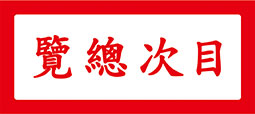




























電子版邀請卡暨海報
邀請卡正面之一
邀請卡正面之二
邀請卡背面之一
邀請卡背面之二
現場海報
現場海報
新聞稿
『中華文化之滅絕與復興:
民國三十八年至六十五年列傳初編文物展覽』
國立臺灣師範大學藝術中心德群畫廊
中華民國一百零八年八月三日至八月十八日
新聞稿
今年值中央政府播遷來臺七十周年,民國三十八年至六十五年際,中共全面消滅中華文化,以文化大革命終。中華民國政府帶領全民推行中華文化復興運動,從政治、生活、教育、藝術、出版多方面進行,成果鉅大,至今大陸知識界普遍認為臺灣完整保存中華文化。
是展介紹中華文化在臺灣、香港、美國、歐洲復興的重要人物,分類有政治家、軍事家、實業家暨經濟學家、儒家領袖、宗教領袖 (道教、佛教、回教、天主教、基督教)、思想家、政論家、學人、舊文學家、新文學家、書法家、畫家、篆刻家、鑑賞家、戲劇家、古箏暨古琴宗師、攝影家、太極拳宗師、中醫師、工程師、建築師、科學家、海外人士 (香港、美國、歐洲)。
共展出一百八十六位中外賢達暨名士之書法、繪畫、信札、印章、著作。人物有先總統 蔣公、蔣夫人、俞大維、李國鼎、孫運璿、孔德成、章嘉、于斌、胡適、傅斯年、溥儒、林語堂、莊嚴、張大千、曽紹杰、齊如山、郎靜山、吳大猷、錢穆、賽珍珠等。 可謂前所未見之盛大。
是展人物包括香港及美歐,冀從世界宏觀回顧中華文化之復興。
是展既集一百八十六人之多,冀能重建數十年前之世界於今日,使參觀者更明瞭當年歷史。
是展冀鑑古知今,更鞭策未來。近年中華民國政府積極消滅中華文化與歷史,使今天年輕一代對中華文化不熟悉也未必認同。
是展求能拋磚引玉,期待明年中華民國政府有抱負與意志,再高舉中華文化復興之大旗,拿回領導中華文化復興的國際地位,拿回繼承五千年中國歷史道統的國際地位。
是展歡迎社會各界蒞臨指教。
松濤社-我愛國旗委員會敬啓
開幕儀式程序
『中華文化之滅絕與復興:
民國三十八年至六十五年列傳初編文物展覽』
國立臺灣師範大學藝術中心德群畫廊
中華民國一百零八年八月三日開幕儀式程序
(1) 14:00 司儀介紹貴賓
(2) 14:05 唱國歌
(3) 14:10 伍前部長世文代表主辦單位致辭
(4) 14:25 吳主席敦義致辭
(5) 14:40 策展人宋緒康致辭
(6) 14:55 呼口號 (中華民國萬歲)
(7) 15:00 專題演講 (武之璋先生)
(8)15:15 專題演講 (張曉風女士)
(9)15:30 策展人宋緒康導覽
(10) 15:45 戶外茶敘
(11) 17:30 開幕儀式結束


















文革時期中華文化在台灣!張大千畫作、郎靜山攝影、胡適信箋真跡 186位名流文物一次看
《風傳媒》專訪》中國搞文革時,台灣這樣推動文化復興!宋緒康辦展,186位名人文物重現中華民國建國史
《風傳媒》專訪》「民進黨出於政治考量湮蓋歷史」 宋緒康:文化再起,民間力量更純粹

展覽手冊封面及封底
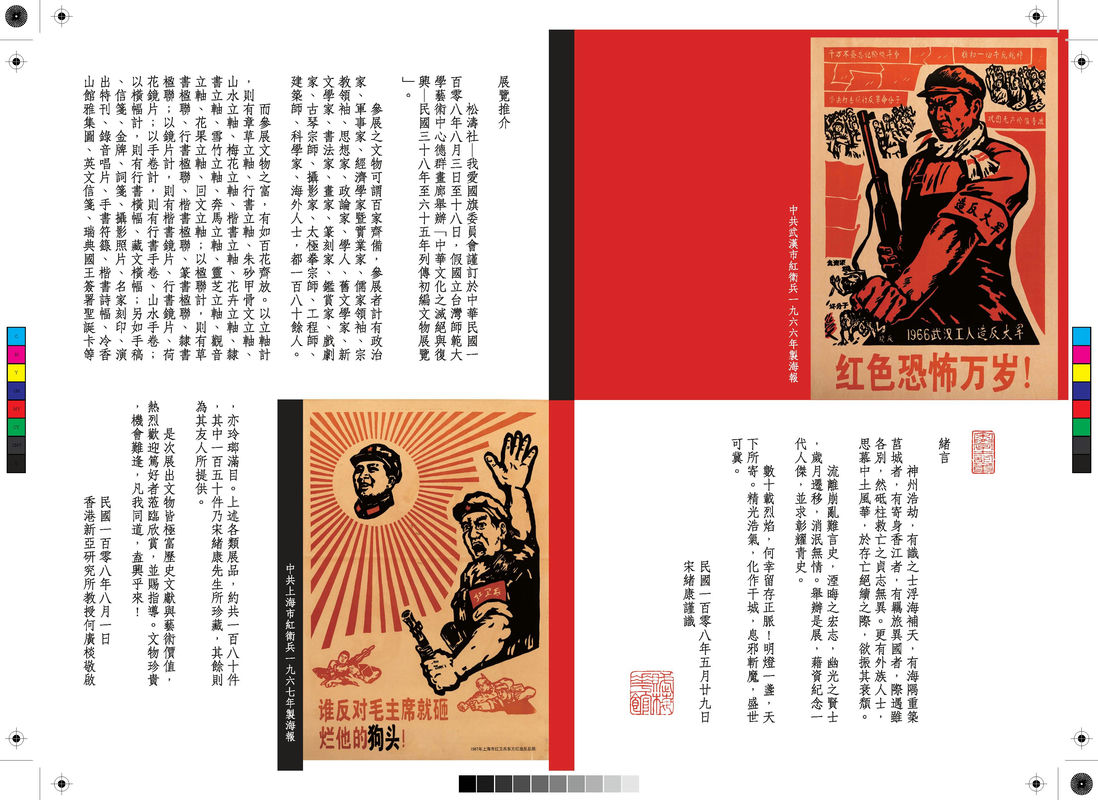
展覽手冊內頁之一
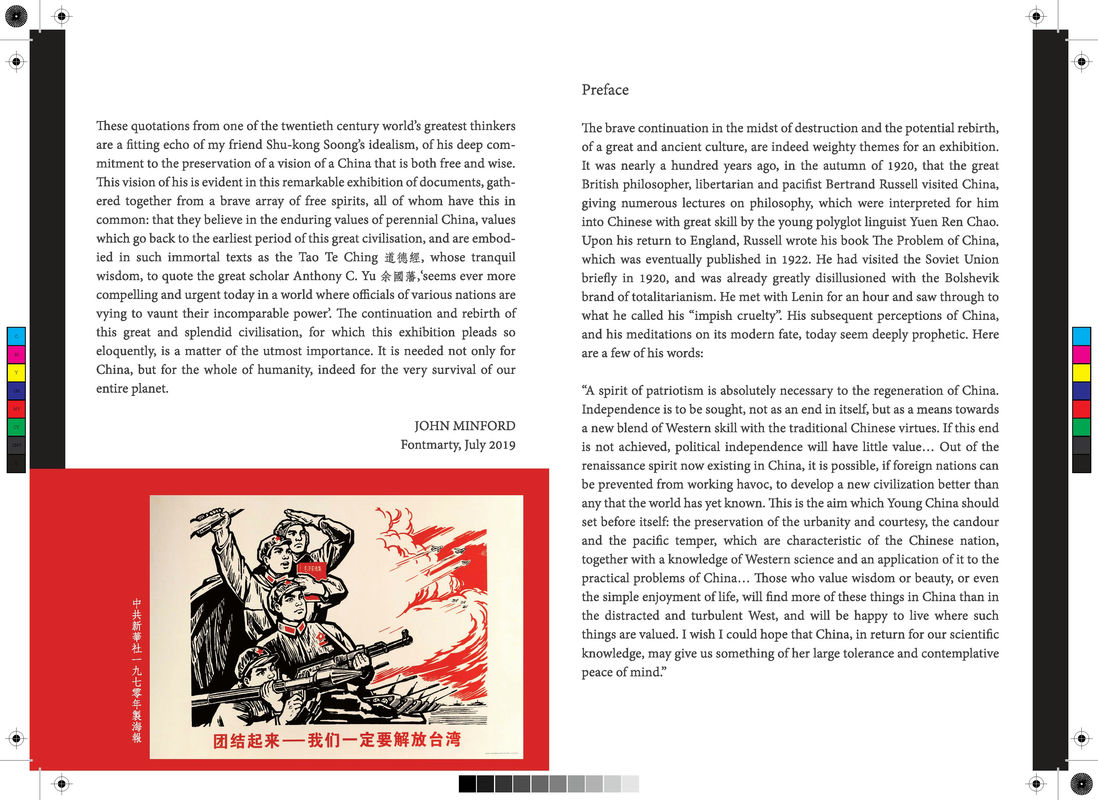
展覽手冊內頁之二

展覽手冊內頁之三
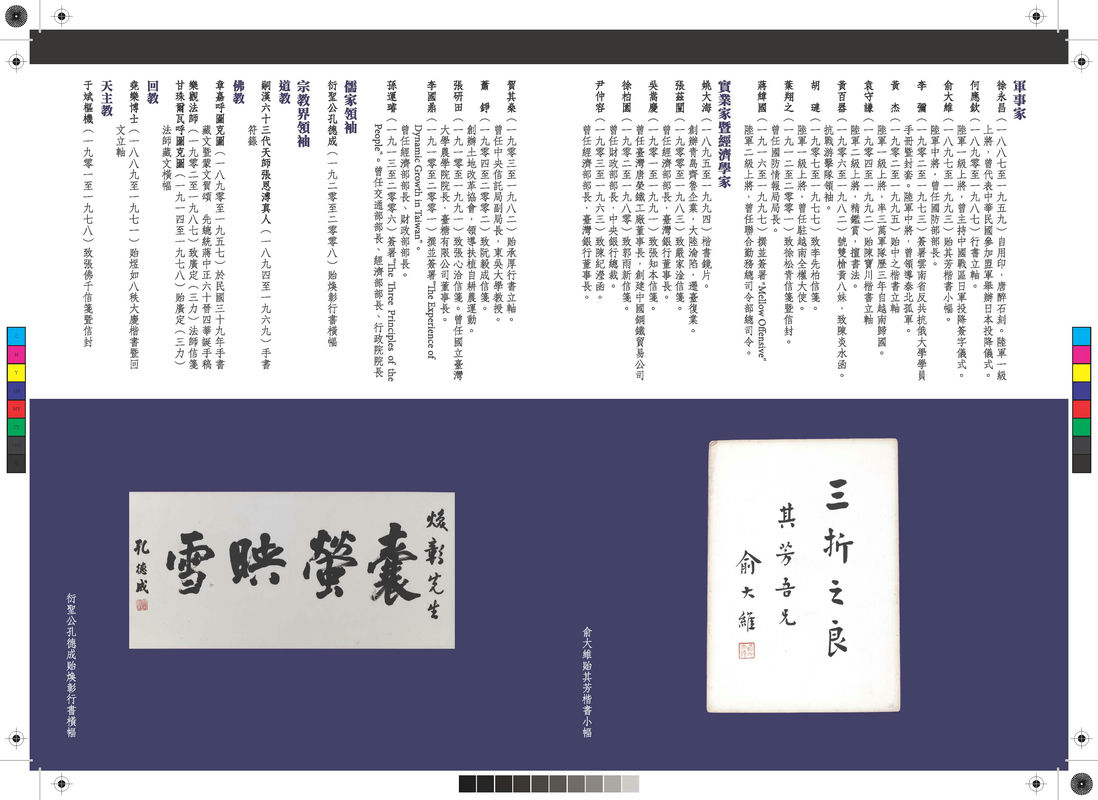
展覽手冊內頁之四

展覽手冊內頁之五
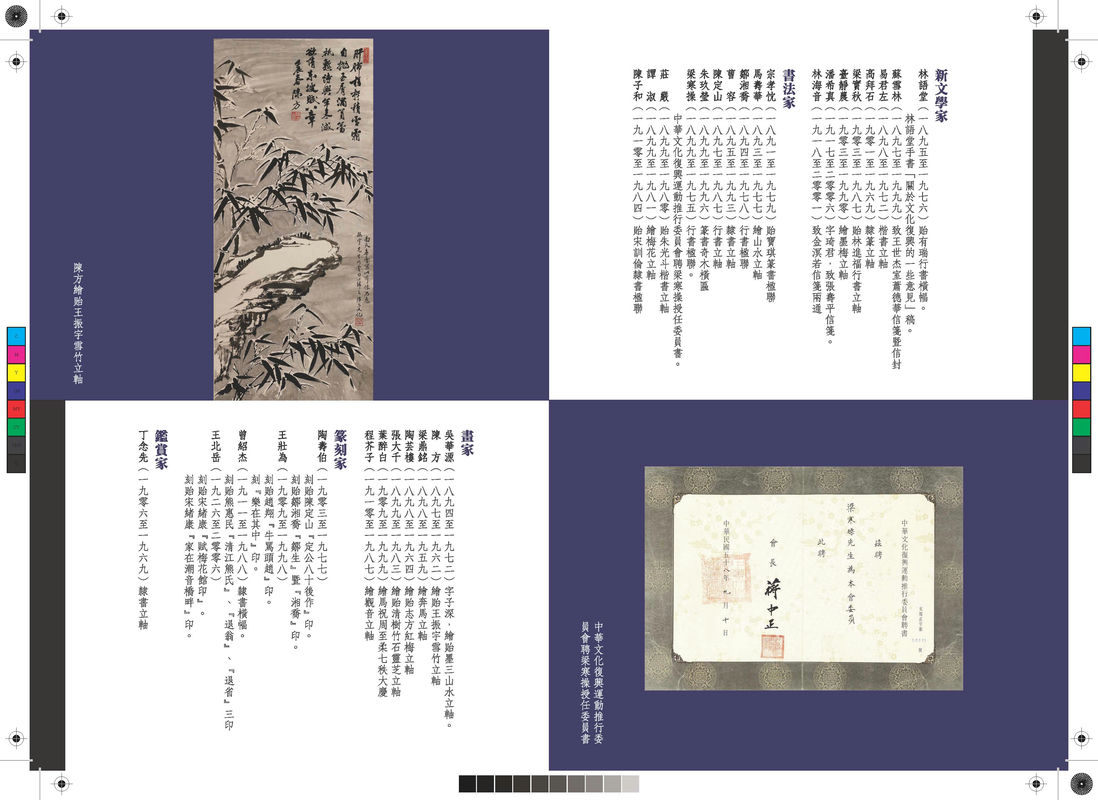
展覽手冊內頁之六

展覽手冊內頁之七

展覽手冊內頁之八
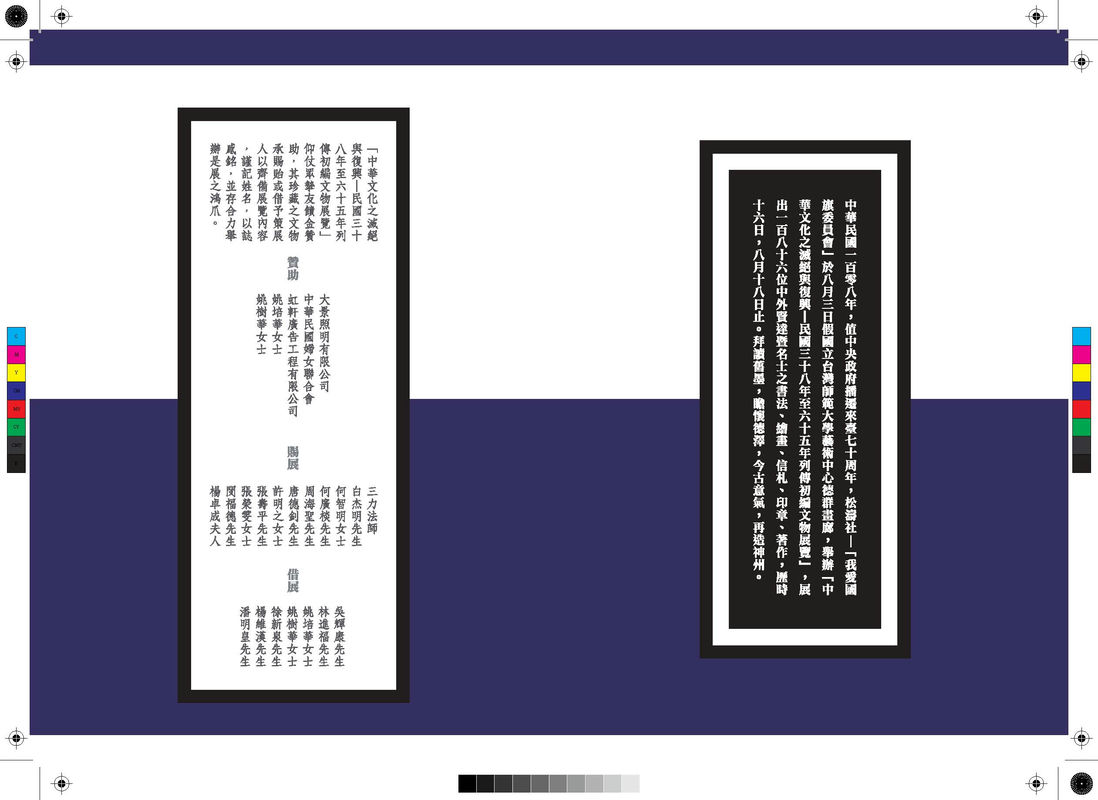
展覽手冊內頁之九

展覽手冊封面

展覽手冊封底
「緒言」,宋緒康先生撰
神州浩劫,有識之士浮海補天,有海隅重築莒城者,有寄身香江者,有羈旅異國者,際遇雖各別,然砥柱救亡之貞志無異。更有外族人士,思慕中土風華,於存亡絕續之際,欲振其衰頹。
流離崩亂難言史,湮晦之宏志,幽光之賢士,歲月遷移,消泯無情。舉辦是展,藉資紀念一代人傑,並求彰耀青史。
數十載烈焰,何幸留存正脈!明燈一盞,天下所寄。精光浩氣,化作干城,息邪斬魔,盛世可冀。
民國一百零八年五月廿九日,
宋緒康謹識。
「展覽推介」,何廣棪教授撰
松濤社-我愛國旗委員會謹訂於中華民國一百零八年八月三日至十八日,假國立台灣師範大學藝術中心德群畫廊舉辦「中華文化之滅絕與復興-民國三十八年至六十五年列傳初編文物展覽」。
參展之文物可謂百家齊備,參展者計有政治家、軍事家、經濟學家暨實業家、儒家領袖、宗教領袖、思想家、政論家、學人、舊文學家、新文學家、書法家、畫家、篆刻家、鑑賞家、戲劇家、古琴宗師、攝影家、太極拳宗師、工程師、建築師、科學家、海外人士,都一百八十餘人。
而參展文物之富,有如百花齊放。以立軸計,則有章草立軸、行書立軸、朱砂甲骨文立軸、山水立軸、梅花立軸、楷書立軸、花卉立軸、隸書立軸、雪竹立軸、奔馬立軸、靈芝立軸、觀音立軸、花果立軸、回文立軸;以楹聯計,則有草書楹聯、行書楹聯、楷書楹聯、篆書楹聯、隸書楹聯;以鏡片計,則有楷書鏡片、行書鏡片、荷花鏡片;以手卷計,則有行書手卷、山水手卷;以橫幅計,則有行書橫幅、藏文橫幅;另如手稿、信箋、金牌、詞箋、攝影照片、名家刻印、演出特刊、錄音唱片、手書符籙、楷書詩幅、冷香山館雅集圖、英文信箋、瑞典國王簽署聖誕卡等,亦玲瑯滿目。上述各類展品,約共一百八十件,其中一百五十件乃宋緒康先生所珍藏,其餘則為其友人所提供。
是次展出文物皆極富歷史文獻與藝術價值,熱烈歡迎篤好者蒞臨欣賞,並賜指導。文物珍貴,機會難逢,凡我同道,盍興乎來!
民國一百零八年八月一日,
香港新亞研究所教授何廣棪敬啟。
「序文」,閔福德教授撰
The brave continuation in the midst of destruction and the potential rebirth, of a great and ancient culture, are indeed weighty themes for an exhibition. It was nearly a hundred years ago, in the autumn of 1920, that the great British philosopher, libertarian and pacifist Bertrand Russell visited China, giving numerous lectures on philosophy, which were interpreted for him into Chinese with great skill by the young polyglot linguist Yuen Ren Chao. Upon his return to England, Russell wrote his book The Problem of China, which was eventually published in 1922. He had visited the Soviet Union briefly in 1920, and was already greatly disillusioned with the Bolshevik brand of totalitarianism. He met with Lenin for an hour and saw through to what he called his “impish cruelty”. His subsequent perceptions of China, and his meditations on its modern fate, today seem deeply prophetic. Here are a few of his words:
“A spirit of patriotism is absolutely necessary to the regeneration of China. Independence is to be sought, not as an end in itself, but as a means towards a new blend of Western skill with the traditional Chinese virtues. If this end is not achieved, political independence will have little value… Out of the renaissance spirit now existing in China, it is possible, if foreign nations can be prevented from working havoc, to develop a new civilization better than any that the world has yet known. This is the aim which Young China should set before itself: the preservation of the urbanity and courtesy, the candour and the pacific temper, which are characteristic of the Chinese nation, together with a knowledge of Western science and an application of it to the practical problems of China… Those who value wisdom or beauty, or even the simple enjoyment of life, will find more of these things in China than in the distracted and turbulent West, and will be happy to live where such things are valued. I wish I could hope that China, in return for our scientific knowledge, may give us something of her large tolerance and contemplative peace of mind. ”
These quotations from one of the twentieth century world's greatest thinkers are a fitting echo of my friend Shu-kong Soong's idealism, of his deep commitment to the preservation of a vision of a China that is both free and wise. This vision of his is evident in this remarkable exhibition of documents, gathered together from a brave array of free spirits, all of whom have this in common: that they believe in the enduring values of perennial China, values which go back to the earliest period of this great civilisation, and are embodied in such immortal texts as the Tao Te Ching (道德經), whose tranquil wisdom, to quote the great scholar Anthony C. Yu (余國藩), “seems ever more compelling and urgent today in a world where offcials of various nations are vying to vaunt their incomparable power”. The continuation and rebirth of this great and splendid civilization, for which this exhibition pleads so eloquently, is a matter of the utmost importance. It is needed not only for China, but for the whole of humanity, indeed for the very survival of our entire planet.
John Minford
Fontmarty, July 2019

電子版邀請卡暨海報.jpg)
邀請卡正面之一.jpg)
邀請卡正面之二.jpg)
邀請卡背面之一.jpg)
邀請卡背面之二.jpg)
現場海報.jpg)
現場海報.jpg)
